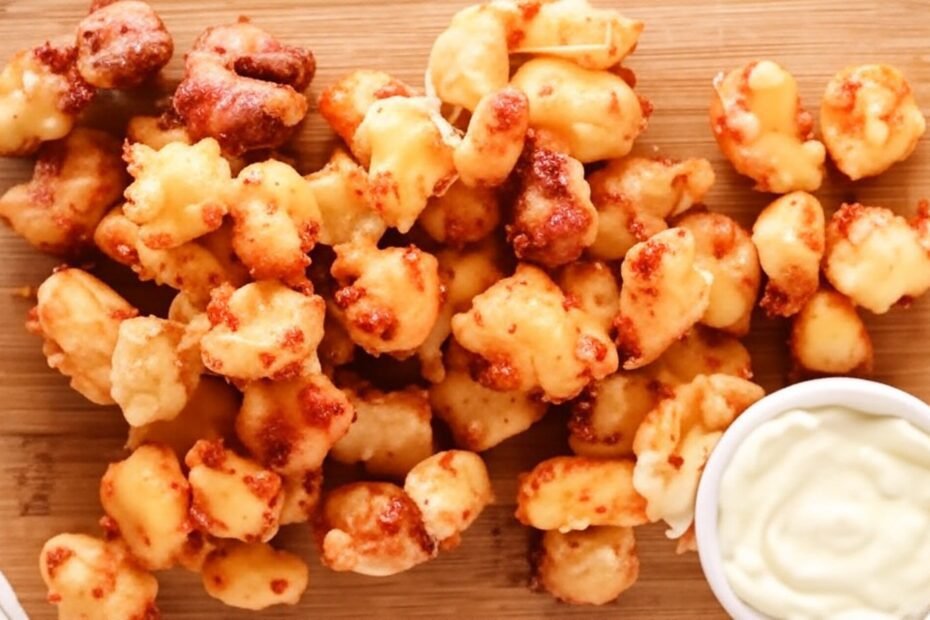If there’s one bite of food that perfectly captures the comfort and charm of the American Midwest, it’s cheese curds. Whether you find them fresh and squeaky from a Wisconsin dairy or golden and crispy from a Minnesota bar menu, cheese curds are pure joy—rich, salty, and undeniably addictive.
As someone who has driven winding roads through Wisconsin farmland and sat at family-run taverns in Iowa, I can tell you this: cheese curds are more than a snack. They’re a cultural staple. Locals debate which dairy makes the best curds, and Midwesterners know the telltale squeak of a truly fresh curd means you’re getting the good stuff.
Let’s explore where these little nuggets come from, why they matter, and how you can make the ultimate fried cheese curds right at home.
What Are Cheese Curds?
Cheese curds are the fresh, springy chunks of curdled milk that form in the early stages of making cheddar cheese. Before they’re pressed into blocks and aged into the sharp cheddar we know, they’re cut into bite-sized pieces and lightly salted.
Fresh cheese curds have a distinctive “squeak” when you bite into them—this happens because the protein strands in the curd rub against your teeth. That squeak fades after about 24 hours, which is why Midwesterners chase them down the day they’re made.
Where to Find the Best Cheese Curds
Wisconsin is ground zero for cheese curds in the U.S.—some say it’s the only place to eat them truly fresh. You’ll see roadside signs reading “Fresh Curds Today” in dairy towns like Monroe, Ellsworth, and Plymouth. Many cheese factories sell them straight from the vat.
Minnesota, Iowa, and Illinois also have their curd claims, especially when it comes to fried versions served at fairs and sports bars. If you’ve ever had beer-battered cheese curds with ranch on the side and a cold pint of lager, you know what I’m talking about.
How to Make Fried Cheese Curds at Home
Fried cheese curds are crisp on the outside, gooey on the inside, and surprisingly easy to make. Here’s how you can bring this Midwestern delicacy into your kitchen, no matter where you live.
Ingredients:
- 1 pound fresh white or yellow cheese curds (preferably cheddar)
- 1 cup all-purpose flour
- 1/2 cup cornstarch
- 1 teaspoon baking powder
- 1 teaspoon garlic powder (optional)
- 1/2 teaspoon salt
- 1 egg
- 3/4 cup beer or club soda (cold)
- Oil for frying (canola or vegetable)
Optional:
- Ranch or marinara for dipping
Instructions:
1. Prep the Cheese Curds
If your curds have been refrigerated, let them come to room temperature for 20–30 minutes before frying. This helps them melt properly inside the batter.
2. Make the Batter
In a mixing bowl, whisk together the flour, cornstarch, baking powder, salt, and garlic powder. Beat in the egg and gradually add beer (or club soda), whisking until smooth. The batter should be thick but pourable, like pancake batter.
3. Heat the Oil
Heat oil in a deep fryer or heavy-bottomed pot to 375°F (190°C). Use a thermometer to maintain steady heat—it’s key for a crisp, golden finish.
4. Batter and Fry
Dip each cheese curd into the batter, letting excess drip off. Carefully drop them into the hot oil, working in small batches. Fry for 1–2 minutes or until golden brown.
5. Drain and Serve
Remove with a slotted spoon and place on paper towels to drain. Serve immediately with your favorite dipping sauce.
Tips for Curd Success
- Use fresh curds. The fresher, the better—they melt better and taste brighter.
- Keep the oil hot. If it drops below 350°F, the batter will soak up oil and turn greasy.
- Don’t crowd the pot. Frying too many at once cools the oil and ruins the crunch.
The Squeaky Soul of the Midwest
In the Midwest, cheese curds are more than a novelty—they’re a taste of heritage, of dairy pride, and of small-town tradition. Whether you’re grabbing a bag at a roadside stand or dunking a hot, fried curd into ranch dressing at your local bar, you’re experiencing a beloved regional treasure.
And now, with a handful of ingredients and a few minutes at the stove, you can experience that cheesy joy wherever you are. Just don’t be surprised if your friends start asking for another batch before you’ve finished the first one.
